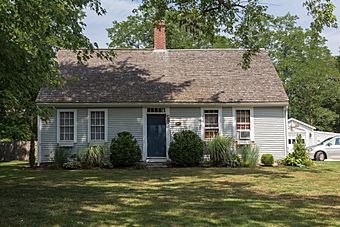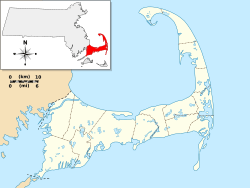William and Jane Phinney House facts for kids
Quick facts for kids |
|
|
William and Jane Phinney House
|
|

William and Jane Phinney House in 2014
|
|
| Location | 555 Phinney's Lane, Barnstable, Massachusetts |
|---|---|
| Built | 1730 |
| Architect | Phinney, William |
| MPS | Barnstable MRA |
| NRHP reference No. | 87000284 |
| Added to NRHP | March 13, 1987 |
The William and Jane Phinney House is a very old and special house located at 555 Phinney's Lane in Centerville, which is part of Barnstable, Massachusetts. It was built around 1730. This house is the oldest one still standing in the village. It's famous for its unique "bowed roof," which looks like a ship's hull turned upside down. This style was common in the Cape Cod area. The house was added to the National Register of Historic Places in 1987. This means it's an important building worth protecting because of its history.
Exploring the Phinney House
The William and Jane Phinney House is in the northern part of Centerville. You can find it on the north side of Phinney's Lane, where it meets Richard's Lane.
What the House Looks Like
This house is one and a half stories tall. It is made of wood and has a special "bowed gable roof." This roof curves gently, like the bottom of a boat. It also has a chimney in the middle and its outside walls are covered with clapboards.
The front of the house is balanced, with five window sections. The main door is in the center. Above the door, there is a small window with four glass panes. Inside, you can still see the original wooden beams that hold the house up. Many other features from the 1700s are also still there. The only big changes have been adding electricity and plumbing.
A Glimpse into History
People in the area believe that the oldest part of this house was built around 1730. It was likely built by William Phinney, who was the first owner. This part of Centerville was one of the first places where European settlers built homes.
The house is important because it's an early example of a "bowed roof." This unique roof style was often used by carpenters who also worked on building ships. It shows how shipbuilding skills influenced house design in the region.




